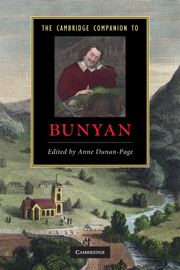Book contents
- Frontmatter
- Introduction
- Part I John Bunyan in his seventeenth-century context
- 1 John Bunyan’s literary life
- 2 John Bunyan and Restoration literature
- 3 John Bunyan and the Bible
- 4 John Bunyan and the goodwives of Bedford: a psychoanalytic approach
- Part II John Bunyan’s major works
- Part III Readership and reception
- Guide to further reading
- Index
2 - John Bunyan and Restoration literature
from Part I - John Bunyan in his seventeenth-century context
Published online by Cambridge University Press: 28 July 2010
- Frontmatter
- Introduction
- Part I John Bunyan in his seventeenth-century context
- 1 John Bunyan’s literary life
- 2 John Bunyan and Restoration literature
- 3 John Bunyan and the Bible
- 4 John Bunyan and the goodwives of Bedford: a psychoanalytic approach
- Part II John Bunyan’s major works
- Part III Readership and reception
- Guide to further reading
- Index
Summary
Most of the works John Bunyan published in print, and indeed most of what he wrote, was compiled during the Restoration. This was a period with clear boundaries in English history, witnessing the return of the monarchy in the shape of the two sons of Charles I, first Charles II between 1660 and 1685 and then James II between 1685 and 1688. The shape of these regimes was particularly relevant to Bunyan since as a dissenter he suffered from the policies of religious discrimination that the government of each monarch adopted towards Protestant nonconformists, although James II favoured toleration of dissenters in order to gain the same for Roman Catholics. The pathetic end of James's reign in the Glorious Revolution, in the year of Bunyan's death, ensured greater freedom for dissenters and the end of the 'great persecution', but even before Charles's ascent to the throne in 1660 the twenty years of the 'Puritan Revolution' had seen advocates of the Baptist Calvinism for which Bunyan stood grow from a tiny and persecuted minority to become a flourishing community. The fortunes of the literary history of the Restoration fluctuate. Eighty years ago drama, much of it libertine in character, was the subject of much fascination. Three or four decades ago, a flourishing industry was devoted to reconstructing and restoring the texts, reputation and activities of John Dryden. Between the 1960s and the 1980s, however, the Restoration was largely eclipsed by the dazzle of the 1640s and 1650s, and study of major Restoration themes and authors dwindled significantly, with the possible exception of the study of Puritan literature.
- Type
- Chapter
- Information
- The Cambridge Companion to Bunyan , pp. 26 - 38Publisher: Cambridge University PressPrint publication year: 2010
- 1
- Cited by

